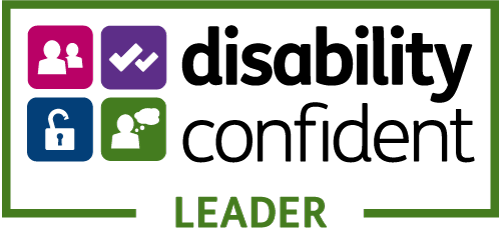Disability Confident
The Disability Confident scheme is creating a movement of change, encouraging employers to think differently about disability and take action to improve how they recruit, retain and develop employees with disabilities.
The University of Huddersfield is proud to have been accredited as a Disability Confident Leader, building on our previous accreditation as a Level 2 Disability Confident Employer.
In continuing our Disability Confident journey, the University will act as a champion for Disability Confident within our local and business communities, encouraging and supporting other organisations in our supply chain(s) and networks to become Disability Confident.

To achieve the Disability Confident Leader accreditation, the University is delivering against the following commitments:
- Actively looking to attract and recruit disabled people
- Providing a fully inclusive and accessible recruitment process
- Offering an interview to disabled people who meet the minimum criteria for the job
- Being flexible when assessing people so disabled job applicants have the best opportunity to demonstrate that they can do the job
- Proactively offering and making reasonable adjustments as required
- Encouraging our suppliers and partner firms to be Disability Confident
- Ensuring employees have appropriate disability equality awareness
- Providing an environment that is inclusive and accessible for staff, students, and visitors to the University.
- Promoting a culture of being Disability Confident
- Supporting employees to manage their disabilities or health conditions
- Ensuring there are no barriers to the development and progression of disabled staff
- Ensuring managers are aware of how they can support staff who are sick or absent from work
- Valuing and listening to feedback from disabled staff
- Reviewing our Disability Confident self-assessment regularly
- Committing to publish an annual report detailing our progression and impact measures in relation to Disability, Mental Health and Wellbeing
Guidance and Resources for Staff
What is a Disability?
The World Health Organisation defines disability as part of being human and integral to the human experience.
What is Neurodiversity?
Find out more about neurological differences and specific learning differences and find sources of support.
Reasonable Adjustments and HAPs
We endeavour to be accessible, inclusive and remove barriers for all. Find out more about reasonable adjustments, Health Adjustment Passports and Access to Work.
Disability Staff Network and Neurodiversity Group
Find out more about the Staff Disability Network and the Neurodiversity Staff Group.
Assistance Dog Guidance
Read the University procedure for students, staff and visitors bringing assistance dogs on to campus.
Personal Emergency Evacuation Plan (PEEP) Guidance
If you have a disability or condition that may affect your evacuation in an emergency, it is essential that you read about the PEEP process.
Campus Accessibility
Find out about some of the facilities that help the University to be a welcoming and inclusive environment.
Digital Accessibility
Find out more about digital accessibility and how to make your digital content and services inclusive by design and accessible to all.

